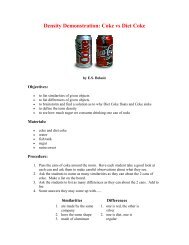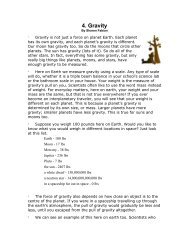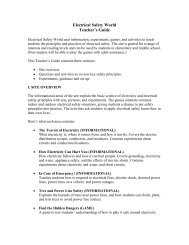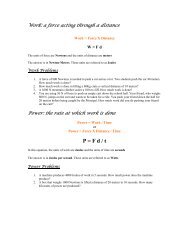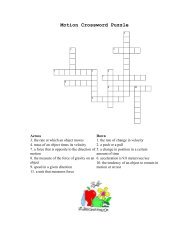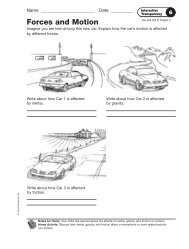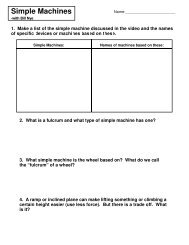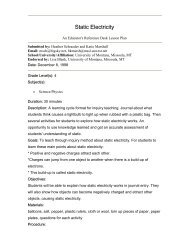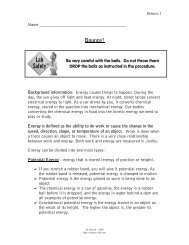Investigating Pulleys
Investigating Pulleys
Investigating Pulleys
Create successful ePaper yourself
Turn your PDF publications into a flip-book with our unique Google optimized e-Paper software.
<strong>Investigating</strong> <strong>Pulleys</strong> 1Name _____________________________<strong>Investigating</strong> <strong>Pulleys</strong>Question: How does the type of pulley system affect the mechanical advantageprovided by the pulley?Hypothesis: Use an If, Then statement to make a hypothesis for the abovequestion.________________________________________________________________________________________________________________________________________________________________________________________________________________________________________________________________________________________________________________________________________________________________Background Information:A pulley system is another type of simple machine. It is made up of a groovedwheel and a rope or line. Like a lever, it provides a MECHANICALADVANTAGE in lifting a heavy load.There are two basic types of pulleys. When the grooved wheel is attached to asurface it makes a FIXED PULLEY. The benefit of a fixed pulley is that it changesthe direction of the required force. For example, to lift an object from the ground, theeffort would be applied downward instead of pulling up on the object. However, afixed pulley provides no mechanical advantage. The same amount of force is still required,but is applied in different direction.M. Poarch – 2002http://science-class.net
<strong>Investigating</strong> <strong>Pulleys</strong> 2Another type of pulley, called a MOVABLE PULLEY, consists of a rope attachedto a surface. The pulley moves along the rope. The wheel supports the load, andthe effort comes from the same direction as the rope attachment. A movable pulleyreduces the effort required to lift a load.EffortLoadThese two types of pulleys can be combined to form DOUBLE PULLEYS, whichhave at least two wheels. There are different combinations that can result in a doublepulley. As the pulley becomes more complex, the total lifting effort decreases. Forexample, a system made of a fixed pulley and a movable pulley would reduce theworkload by a factor of two, because the two pulleys combine to lift the load.Procedure:1. Build a single fixed pulley system.2. Use the spring scale to find the effort needed to lift the load.3. Record in the data chart.4. Build a single movable pulley system.5. Use the spring scale to find the effort needed to lift the load.6. Record in the data chart7. Build a single fixed / single movable pulley system.8. Use the spring scale to find the effort needed to lift the load.9. Record in the data chart10. Build a different single fixed / single movable pulley system.11. Use the spring scale to find the effort needed to lift the load.12. Record in the data chartM. Poarch – 2002http://science-class.net
<strong>Investigating</strong> <strong>Pulleys</strong> 3Data:Pulley SystemNumber of<strong>Pulleys</strong>Direction ofEffort/ForceLoad inNewtonsEffort/Force inNewtonsSingle FixedSingle MovableSingle Fixed / SingleMovableSingle Fixed / SingleMovableAnalyze Data:Make a Bar Graph to show the pulley system data – the type of pulley and the effortit takes to lift the load. Remember title, labels, correct units of measurement, andspacing.What relationship does the data show?________________________________________________________________________________________________________________________________________________________________________________M. Poarch – 2002http://science-class.net
M. Poarch – 2002http://science-class.net<strong>Investigating</strong> <strong>Pulleys</strong> 4
<strong>Investigating</strong> <strong>Pulleys</strong> 5Questions:1. Why is a bar graph the best graph for this kind of data?___________________________________________________________________________________________________________________________________________________________________________________________________________________________________________________2. What are the independent and dependent variables in this investigation?__________________________________________________________________________________________________________________________________________________________________Conclusion:Write a paragraph answering the original question. Explain why your hypothesiswas supported / not supported using actual data from the experiment.________________________________________________________________________________________________________________________________________________________________________________________________________________________________________________________________________________________________________________________________________________________________________________________________________________________________________________________________________________________________________________________________________________________________________________________________________________________________________________________________________________________________________________________________________________________________________________________________________________________________________________________________________________________________________________________________________________________________________________________________________________________________________________________________________________________________________________________________________________________________________________________M. Poarch – 2002http://science-class.net



